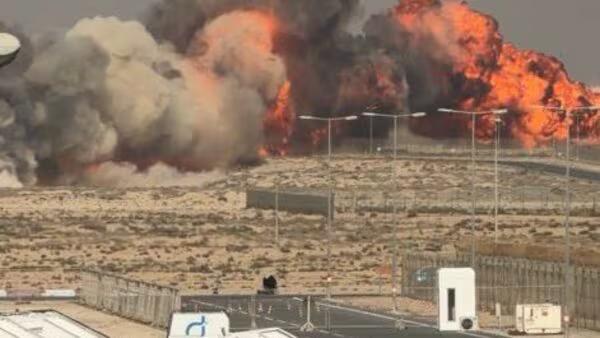Negative G forces, engine seizures, or bird strike: What may have caused the Tejas crash at Dubai air show, and why such tragedies are not unprecedented
The tragic crash of an Indian Air Force (IAF) Tejas fighter jet during an aerial display at the Dubai Air Show has once again brought into focus the extreme risks associated with demonstration flying. The loss of a trained combat pilot is not just a statistic, but a deeply personal national tragedy. Yet, amid the shock, grief and social media speculation, it is crucial to separate emotion from aviation reality. Airshow accidents, while rare, are not abnormal in military aviation across the world, even among the most technologically advanced air forces. Unlike routine operational missions, airshow performances are meant to push aircraft to their visual and aerodynamic limits. These flights are not merely about flying from point A to point B but about executing tightly choreographed, high-stress manoeuvres at low altitudes and critical speeds. The margins for recovery during such performances are razor thin. This makes demonstration flying one of the most dangerous tasks a military pilot can undertake, often riskier than actual combat sorties, because the aircraft is flown in deliberately unstable flight regimes to showcase its agility and capabilities. And such daredevilry can often lead to tragic fatalities as evidenced during one such airshows in Dubai on Friday, November 21, 2025. Preliminary video footage and expert assessments indicate that the Tejas was performing a demanding aerobatic sequence when it began to lose altitude rapidly. While only a formal inquiry can establish the exact sequence of events, aviation experts have highlighted several plausible explanations based on visual evidence and known aerodynamic and physiological risks. It must also be stated unequivocally that no individual, media outlet, or self-styled expert can claim with full authority to know the real cause of the crash until the Indian Air Force’s court of inquiry completes its investigation and formally presents its findings. Aircraft accidents, particularly those involving advanced fighter jets performing extreme aerobatic manoeuvres, are complex events that often result from a chain of mechanical, human, environmental, and procedural factors rather than a single obvious failure. But it has brought to the fore the dangerous life an aviation professional lives, and the level of complexity their job involves, which could often lead to disastrous consequences, sometimes leading to their unfortunate deaths. Negative G manoeuvre and pilot physiological limits One of the most discussed possibilities is the physiological impact of a Negative G manoeuvre. Under normal flight, gravity pulls blood away from the brain. Negative G conditions do the opposite, forcing blood towards the head. This can lead to a phenomenon known as “red-out,” where vision becomes heavily distorted, or in extreme cases, a brief loss of consciousness. During aerobatic loops and inverted segments, the human body can experience disorientation, delayed reflexes and momentary cognitive impairment. Even with advanced training and anti-G conditioning, no pilot is immune to these biological limits. In a high-speed, low-altitude environment, even a split second of incapacitation is enough to make recovery impossible. This explanation does not imply pilot error, but reflects the brutal reality that the aircraft may perform beyond what the human body can reliably tolerate. Engine seizure or momentary power loss Another possible technical factor could be engine seizure or transient power loss during the manoeuvre. Earlier, in the March 2024 Tejas crash near Jaisalmer, investigators traced the cause to an oil pump malfunction that led to engine seizure. While there is no evidence that the Dubai crash involved the same defect, the precedent shows how aggressively flown fighter engines can be vulnerable to lubrication or fuel system disruptions. During Negative G or near-zero gravity phases, fuel and lubricating oil do not behave as they do in straight and level flight. Any momentary interruption in oil pressure or fuel feed can cause brief flameout or thrust loss. In typical operational flying, pilots have altitude and time to attempt relights or emergency procedures. In an airshow, where aircraft are flown deliberately close to the ground to maximise visual impact, there is often no margin to recover if thrust drops unexpectedly. Fly-by-wire and control system sensitivity The Tejas is a digitally controlled, fly-by-wire aircraft, meaning that the pilot’s inputs are interpreted and executed by flight control computers rather than direct mechanical linkages. This architecture allows the aircraft to fly in aerodynamically unstable regimes, dramatically improving agility and performance. However, such systems rely on precise, real-time input from dozens of sensors. A rare sensor glitch, software logic conflict or data misinterpretation under extreme manoeuvring conditions can theoretically lead to unexpected control response



The tragic crash of an Indian Air Force (IAF) Tejas fighter jet during an aerial display at the Dubai Air Show has once again brought into focus the extreme risks associated with demonstration flying. The loss of a trained combat pilot is not just a statistic, but a deeply personal national tragedy.
Yet, amid the shock, grief and social media speculation, it is crucial to separate emotion from aviation reality. Airshow accidents, while rare, are not abnormal in military aviation across the world, even among the most technologically advanced air forces.
Unlike routine operational missions, airshow performances are meant to push aircraft to their visual and aerodynamic limits. These flights are not merely about flying from point A to point B but about executing tightly choreographed, high-stress manoeuvres at low altitudes and critical speeds. The margins for recovery during such performances are razor thin.
This makes demonstration flying one of the most dangerous tasks a military pilot can undertake, often riskier than actual combat sorties, because the aircraft is flown in deliberately unstable flight regimes to showcase its agility and capabilities. And such daredevilry can often lead to tragic fatalities as evidenced during one such airshows in Dubai on Friday, November 21, 2025.
Preliminary video footage and expert assessments indicate that the Tejas was performing a demanding aerobatic sequence when it began to lose altitude rapidly. While only a formal inquiry can establish the exact sequence of events, aviation experts have highlighted several plausible explanations based on visual evidence and known aerodynamic and physiological risks.
It must also be stated unequivocally that no individual, media outlet, or self-styled expert can claim with full authority to know the real cause of the crash until the Indian Air Force’s court of inquiry completes its investigation and formally presents its findings. Aircraft accidents, particularly those involving advanced fighter jets performing extreme aerobatic manoeuvres, are complex events that often result from a chain of mechanical, human, environmental, and procedural factors rather than a single obvious failure.
But it has brought to the fore the dangerous life an aviation professional lives, and the level of complexity their job involves, which could often lead to disastrous consequences, sometimes leading to their unfortunate deaths.
Negative G manoeuvre and pilot physiological limits
One of the most discussed possibilities is the physiological impact of a Negative G manoeuvre. Under normal flight, gravity pulls blood away from the brain. Negative G conditions do the opposite, forcing blood towards the head. This can lead to a phenomenon known as “red-out,” where vision becomes heavily distorted, or in extreme cases, a brief loss of consciousness.
During aerobatic loops and inverted segments, the human body can experience disorientation, delayed reflexes and momentary cognitive impairment. Even with advanced training and anti-G conditioning, no pilot is immune to these biological limits. In a high-speed, low-altitude environment, even a split second of incapacitation is enough to make recovery impossible. This explanation does not imply pilot error, but reflects the brutal reality that the aircraft may perform beyond what the human body can reliably tolerate.
Engine seizure or momentary power loss
Another possible technical factor could be engine seizure or transient power loss during the manoeuvre. Earlier, in the March 2024 Tejas crash near Jaisalmer, investigators traced the cause to an oil pump malfunction that led to engine seizure. While there is no evidence that the Dubai crash involved the same defect, the precedent shows how aggressively flown fighter engines can be vulnerable to lubrication or fuel system disruptions.
During Negative G or near-zero gravity phases, fuel and lubricating oil do not behave as they do in straight and level flight. Any momentary interruption in oil pressure or fuel feed can cause brief flameout or thrust loss. In typical operational flying, pilots have altitude and time to attempt relights or emergency procedures. In an airshow, where aircraft are flown deliberately close to the ground to maximise visual impact, there is often no margin to recover if thrust drops unexpectedly.
Fly-by-wire and control system sensitivity
The Tejas is a digitally controlled, fly-by-wire aircraft, meaning that the pilot’s inputs are interpreted and executed by flight control computers rather than direct mechanical linkages. This architecture allows the aircraft to fly in aerodynamically unstable regimes, dramatically improving agility and performance.
However, such systems rely on precise, real-time input from dozens of sensors. A rare sensor glitch, software logic conflict or data misinterpretation under extreme manoeuvring conditions can theoretically lead to unexpected control responses. These systems are heavily tested and certified, but airshow flying often explores the very edges of the flight envelope. At very low altitudes, even a fractionally delayed or incorrect control response can prove catastrophic. This is not unique to Tejas and has been seen in other advanced fighters worldwide.
Bird strike or foreign object ingestion
Environmental factors must also be considered. Airshows often take place near coastlines or urban areas, which naturally attract bird activity. A bird strike or foreign object ingestion into the engine can cause immediate and severe disruption to airflow, combustion stability or turbine operation.
Such incidents have historically caused crashes and serious incidents in aircraft belonging to some of the world’s most advanced air forces. A bird strike at cruising altitude may be survivable; the same event during a low-level aerobatic sequence can be unrecoverable due to time and height constraints.
Why airshow crashes or mishaps during military exercises are not unprecedented
It is critical to understand that airshow crashes are not unique to India or the Tejas programme. The United States, Russia, France, China and several European nations have all suffered fatal accidents involving frontline fighters during demonstration flights. Aircraft such as the F-16, Su-27, Mirage 2000 and MiG-29 have crashed during airshows despite decades of proven operational reliability.
These accidents occur not because the aircraft are unsafe, but because airshows deliberately compress safety margins to deliver tight, visually dramatic manoeuvres. Risk is an inherent part of such performances.
Recent global examples show that even the most technologically advanced militaries are not immune to mid-air and deck-related accidents. In October 2025, the United States Navy witnessed a rare twin-accident episode over the South China Sea, when an MH-60R Seahawk helicopter and an F/A-18F Super Hornet fighter jet crashed within half an hour of each other while operating from the aircraft carrier USS Nimitz.
A separate tragedy in the United States further illustrated how fragile aviation safety can be even in controlled airspace. A mid-air collision near Washington DC between an American Airlines regional jet and a US Army Black Hawk helicopter ended in disaster near Reagan National Airport. The civilian aircraft, carrying 60 passengers and four crew members, was on approach when it collided with the military helicopter, which was on a training mission.
Both aircraft plunged into the icy Potomac River, with authorities confirming that all 64 civilian occupants and the three soldiers on board were killed. Despite the US having among the most advanced air traffic management systems in the world, the cause was not immediately established, prompting a full National Transportation Safety Board (NTSB) investigation. The airport was shut down, flights diverted and rescue teams battled freezing, low-visibility waters for days, demonstrating that even the most sophisticated civilian and military aviation ecosystems remain vulnerable to human, technical and environmental failures.
Even within purely military environments, the United States Navy has suffered a series of serious incidents in recent years, underlining how operational intensity increases the risk of accidents. In April 2025, an F/A-18 Super Hornet, valued at nearly $60 million, fell off the deck of the aircraft carrier USS Harry S. Truman in the Red Sea along with its towing tractor while the vessel was executing an evasive manoeuvre. At the time, the carrier air wing was conducting active strike operations against Houthi targets, regularly facing hostile drones and missile threats.
Beyond the United States, China has also experienced fatal accidents during demonstration flying, such as the 2016 Danxia airshow crash in which aerobatic champion Michel Leusch was killed when he failed to recover from a vertical dive. Together, these incidents illustrate a sobering reality: high-performance aviation, whether in peacetime displays or combat-adjacent operations, operates permanently at the edge of human and mechanical limits, and no nation, however advanced, is immune to tragedy.
Tejas’ operational track record
The Tejas has been in IAF service since 2016 and has accumulated thousands of safe flying hours across operational patrols, exercises and training missions. The previous 2024 crash near Jaisalmer was traced to a specific, identifiable fault, an engine oil pump malfunction. The corrective process that followed demonstrated that India’s military aviation safety mechanisms are both active and transparent.
It is also significant that the Dubai crash occurred a day after viral claims about oil leaks were officially dismissed by the government. Prematurely linking unrelated claims to an active investigation distorts public understanding and undermines the professionalism of the inquiry process.
A tragedy, not a verdict
While this crash marks the ninth IAF aircraft loss since March 2024 and the second involving Tejas, raw numbers without operational context can mislead. The IAF operates in one of the most demanding flight environments in the world. Accidents, though heartbreaking, are an unfortunate reality of high-performance military aviation.
A Court of Inquiry has been ordered, and only its findings will provide definitive answers. Until then, speculation should be balanced with perspective and restraint.





































































